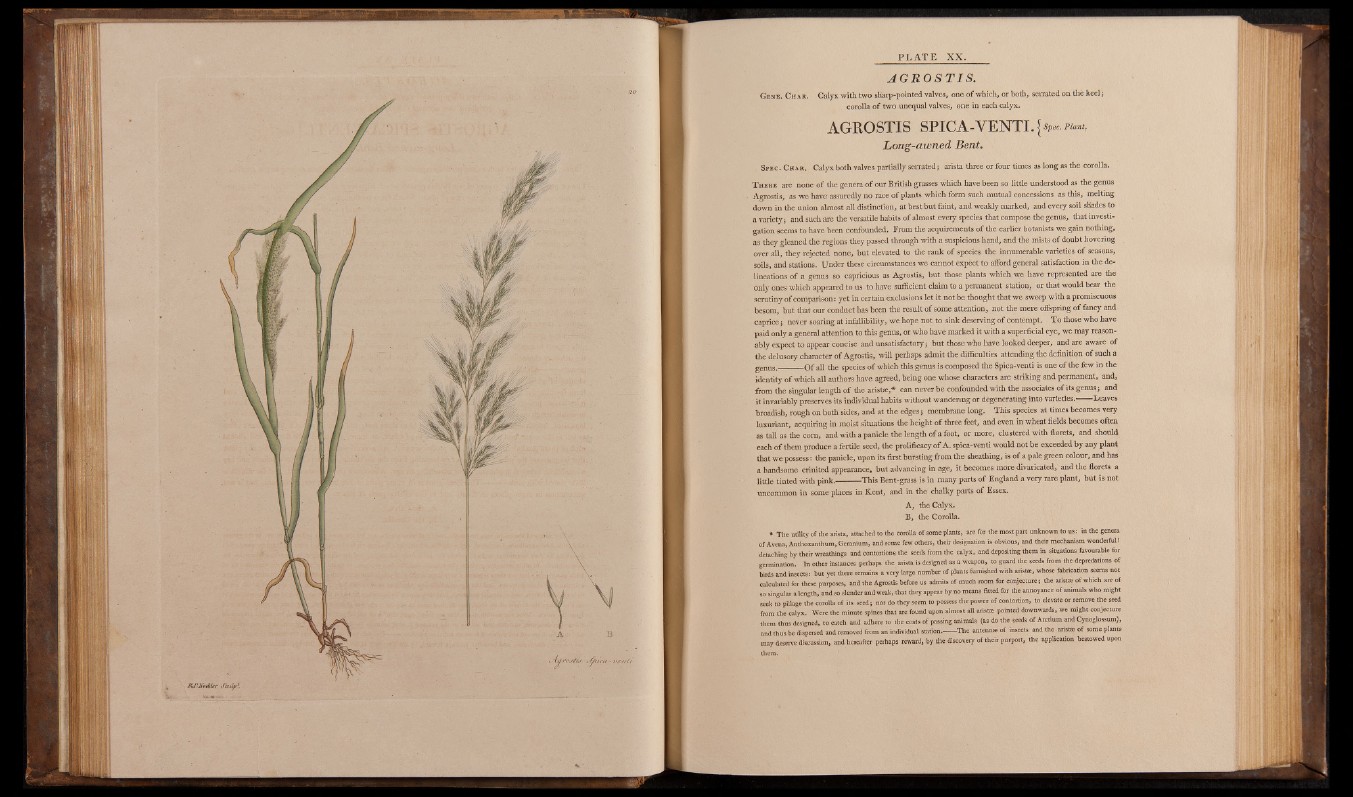
A G R O S T I S .
Gene. Char. Calyx with two sharp-pointed valves, one o f which, or both, serrated on the keel}
corolla o f two unequal valves, one in each calyx.
AGROSTIS SPICA-YENTI. {spec, pum,
Long-awned Bent.
Spec. Char. Calyx both valves partially serrated; arista three or four times as long as the corolla.
T here are none of the genera of our British grasses which have been so little understood as the genus
Agrostis, as we have assuredly no race of plants which form such mutual concessions as this, melting
down in the union almost all distinction, at best but faint, and weakly marked, and every soil shades to
a variety} and such are the versatile habits of almost every species that compose the genus, that investigation
seems to have been confounded. From the acquirements of the earlier botanists we gain nothing,
as they gleaned the regions they passed through with a suspicious hand, and the mists o f doubt hovering
over all, they rejected none, but elevated to the rank of species die innumerable varieties o f seasons,
soils, and stations. Under these circumstances we cannot expect to afford general satisfaction in the delineations
of a genus so capricious as Agrostis, but those plants which we have represented are the
only ones which appeared to us to have sufficient claim to a permanent station, or that would bear the
scrutiny of comparison: yet in certain exclusions let it not be thought that we sweep with a promiscuous
besom, but that our conduct has been the result of some attention, not the mere offspring o f fancy and
caprice} never soaring at infallibility, we hope not to sink deserving o f contempt. To those who have
paid only a general attention to this genus, or who have marked it with a superficial eye, we may reasonably
expect to appear concise and unsatisfactory} but those who have looked deeper, and are aware of
the delusory character of Agrostis, will perhaps admit the difficulties attending the definition o f such a
genus,______O f all the species of which this genus is composed the Spica-venti is one o f the few in the
identity o f which all authors have agreed, being one whose characters are striking and permanent, and,
from the singular length o f the aristae,* can never be confounded with the associates of its genus} and
it invariably preserves its individual habits without wandering or degenerating into varieties. Leaves
broadish, rough on both sides, and at the edges} membrane long. This species at times becomes very
luxuriant, acquiring in moist situations the height o f three feet, and even in wheat fields becomes often
as tall as the com, and with a panicle the length of a foot, or more, clustered with florets, and should
each of them produce a fertile seed, the prolificacy o f A. spica-venti would not be exceeded by any plant
that we possess: the panicle, upon its first bursting from the sheathing, is of a pale green colour, and has
a handsome crinited appearance, but advancing in age, it becomes more divaricated, and the florets a
little tinted with pink.--------- This Bent-grass is in many parts o f England a very rare plant, but is not
uncommon in some places in Kent, and in the chalky parts of Essex.
A, the Calyx.
B, the Corolla.
• The utility of the arista, attached to the corolla of some plants, are for the most part unknown to us: in the genera
of Avena, Anthoxanthum, Geranium, and some few others, their designation is obvious, and their mechanism wonderful!
detaching by their wreathings and contortions the seeds from the calyx, and depositing them in situations favourable for
germination. In other instances perhaps the arista is designed as a weapon, to guard the seeds from the depredations of
birds and insects: but yet there remains a veiy large number of plants furnished with aristae, whose fabrication seems not
calculated for these purposes, and the Agrostis before us admits of much room for conjecture} the aristae of which are of
so singular a length, and so slender and weak, that they appear by no means fitted for the annoyance of animals who might
seek to pillage the corolla of its seed; nor do they seem to possess the power of contortion, to elevate or remove the seed
from the calyx. Were the minute spines that are found upon almost all aristae pointed downwards, we might conjecture
them thus designed, to catch and adhere to the coats of passing animals (as do the seeds of Arctium and Cynoglossum),
and thus be dispersed and removed from an individual station.------The antennae of insects and the aristae of some plants
may deserve discussion, and heseaftcr perhaps reward, by the discovery of their purport, the application bestowed upon
them.